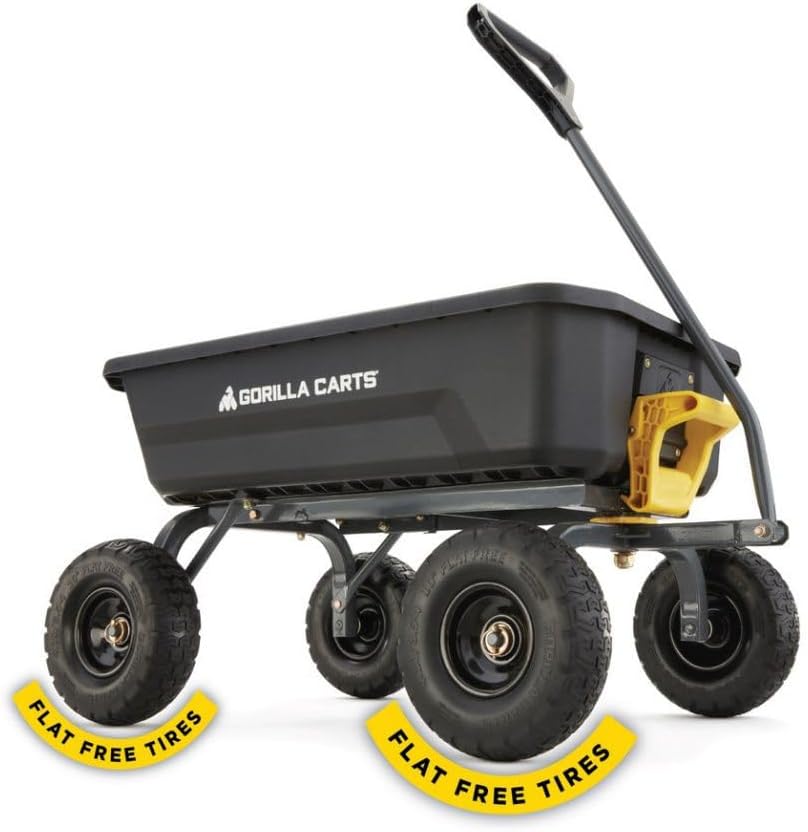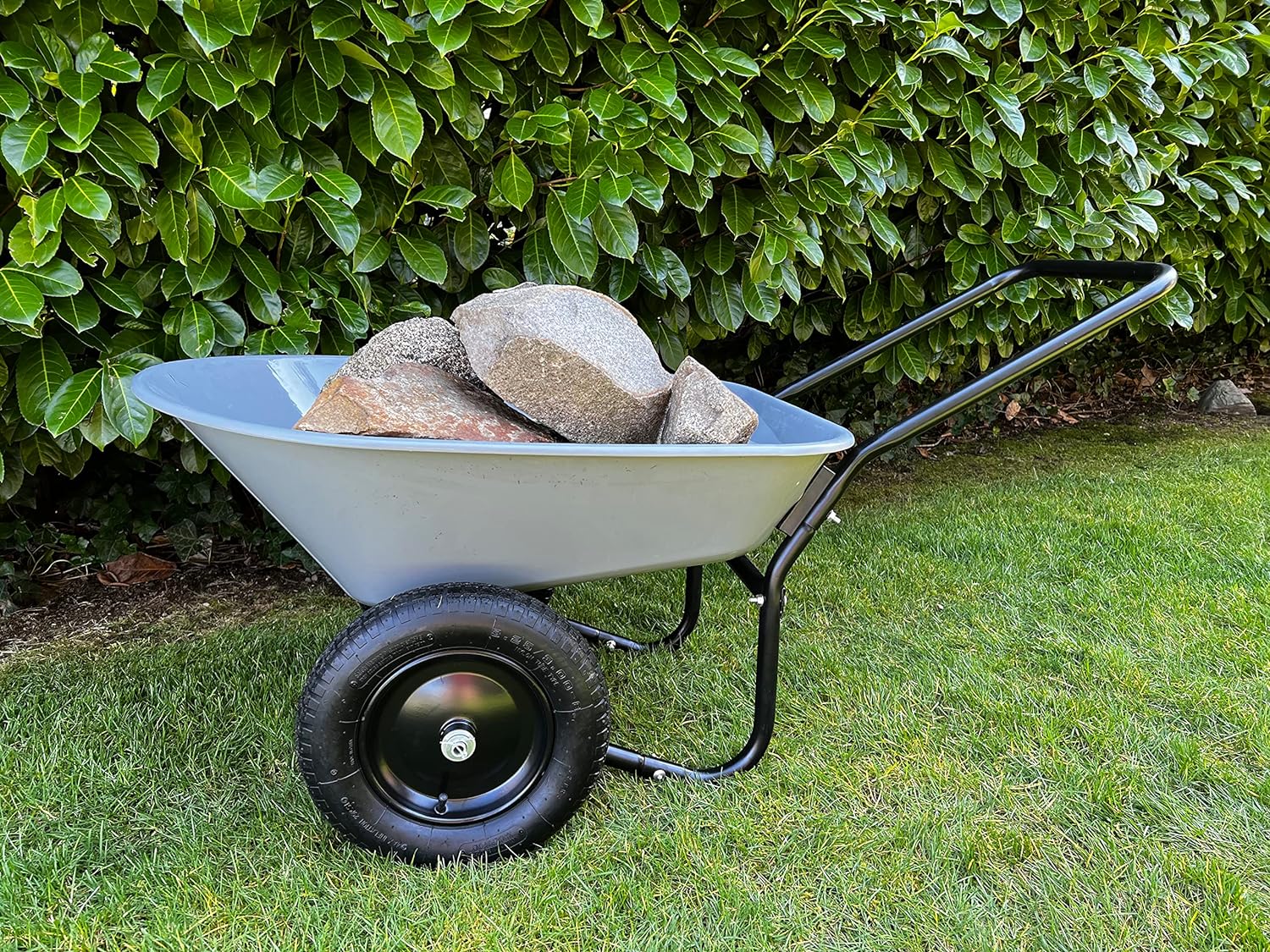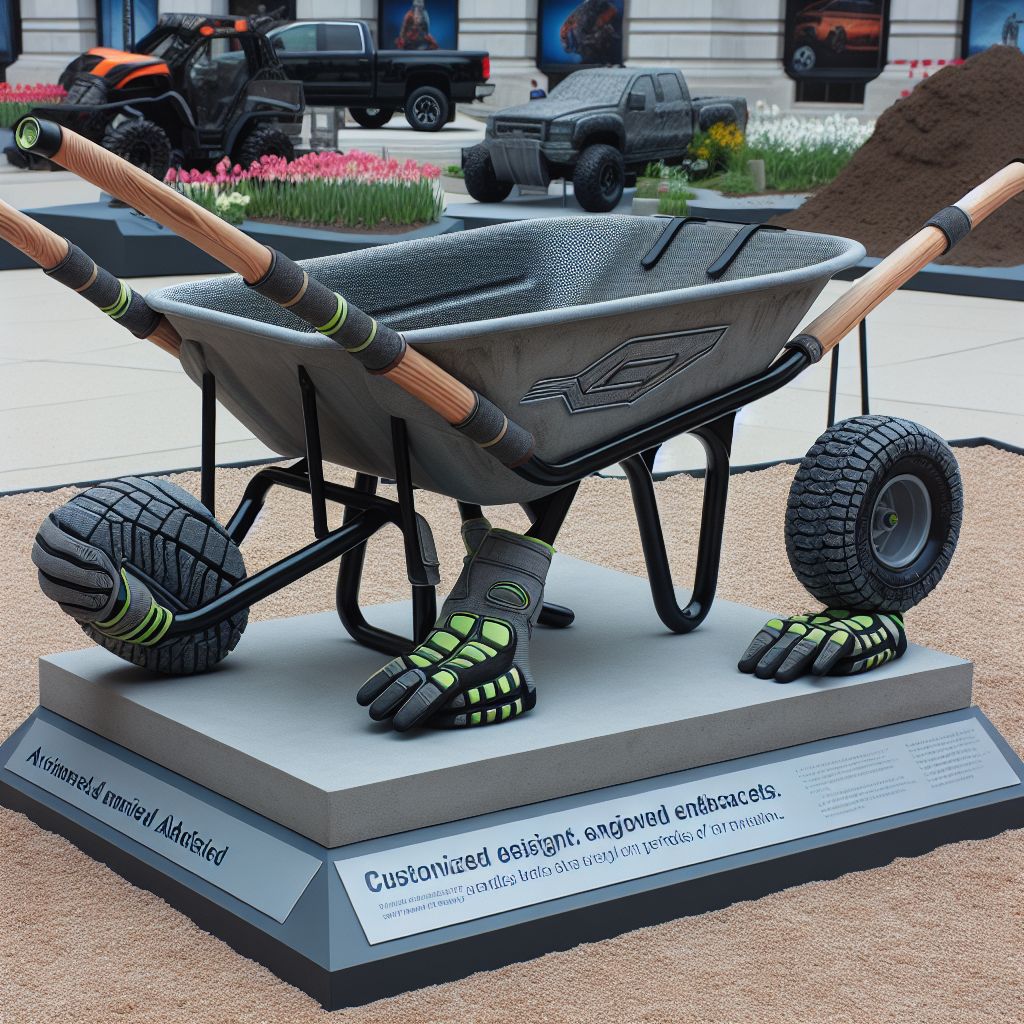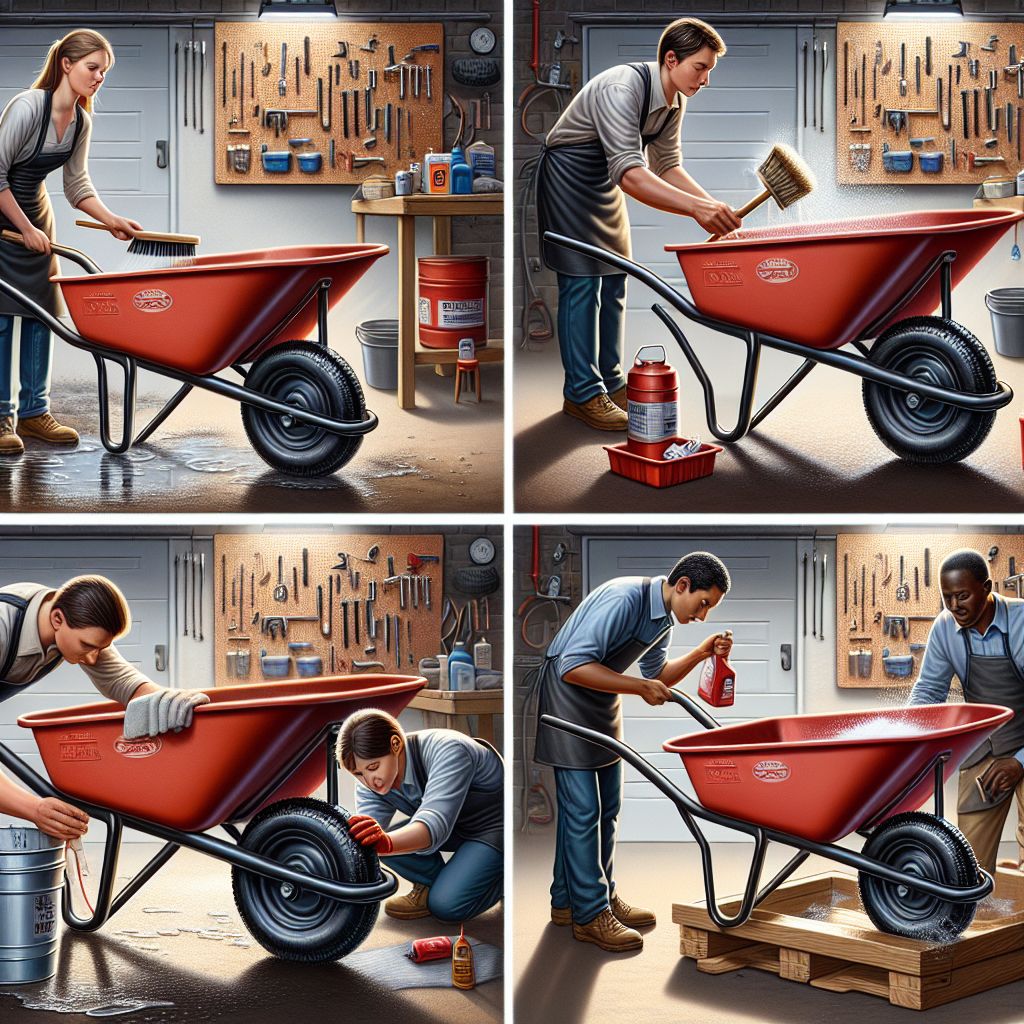Contents
- 1 Your Wheelbarrow Waits: A Gardener’s Ally
- 2 The Heart of the Garden: Wheelbarrow Types Explained
- 3 Volume and Load Capacity: How Much Can It Hold?
- 4 Features and Accessories: Customizing Your Wheelbarrow
- 5 Wheeling Towards Durability: Maintenance and Care
- 6 Where to Buy: Finding the Right Wheelbarrow
- 7 FAQ: Everything Else You Need to Know
- 8 Author
Key Takeaways
-
Choosing the right wheelbarrow is crucial for efficient gardening and can vary based on the type of work you’re doing.
-
Wheelbarrows come in different materials like steel and plastic, each with its own advantages.
-
The number of wheels on a wheelbarrow affects its stability and maneuverability.
-
Load capacity and volume are important to consider to match the wheelbarrow to the task at hand.
-
Maintenance and proper storage of your wheelbarrow will ensure its longevity and performance.
When you’re knee-deep in garden work, the last thing you want is to struggle with an inefficient wheelbarrow. It’s more than just a vessel for hauling soil or compost; it’s a partner in your gardening journey. A good wheelbarrow simplifies your tasks and saves your back, but with so many options out there, how do you choose the right one?
Your Wheelbarrow Waits: A Gardener’s Ally

Let’s get down to the roots of it. A wheelbarrow isn’t just a tool; it’s the backbone of garden work. From moving mulch to carting away clippings, it’s the trusty sidekick you can’t do without. But with the right wheelbarrow, you can turn a backbreaking chore into a walk in the park.
What Makes a Great Wheelbarrow?
Great question! It’s not just about the prettiest wheelbarrow or the one your neighbor swears by. It’s about what works best for you. Are you hauling heavy rocks, or just some leaves and cuttings? Do you have a sprawling garden or just a few raised beds? These are the kind of questions that will steer you towards your perfect match.
Most importantly, a great wheelbarrow feels right when you’re using it. It’s balanced, it’s comfortable, and it doesn’t leave you feeling like you’ve just finished a triathlon after moving a few pots around.
Therefore, let’s break it down into what really matters: material, wheel configuration, load capacity, and those little extras that make all the difference.
Understanding Your Gardening Goals
Before we dive into the nuts and bolts, let’s talk about you. What are you aiming to achieve in your garden? If you’re creating a cozy space with a few flower beds, your needs will be different from someone who’s managing a vegetable plot the size of a soccer field.
Consider the terrain of your garden. Is it hilly or flat? Are the pathways smooth or more like an obstacle course? These factors influence the type of wheelbarrow that will make your gardening not just doable, but enjoyable.
The Heart of the Garden: Wheelbarrow Types Explained
When it comes to wheelbarrows, there’s more variety than you might think. Each type has been designed with a specific purpose in mind, and understanding these can help you make the right choice.
Traditional Single-Wheel: Maneuverability at Its Best

The classic single-wheel wheelbarrow is a garden staple. It’s designed for tight turns and precision movement. With one wheel at the front, you can navigate through narrow garden paths with ease. But remember, it requires a bit of balance, especially when loaded up.
An example of where a single-wheel wheelbarrow shines is when you’re weaving through a crowded vegetable garden, delivering compost directly to your plant beds without trampling over your precious sprouts.
Two-Wheelers: The Stability Champions

If balancing a load isn’t your cup of tea, then a two-wheeled wheelbarrow might be your best bet. These models offer extra stability, so you’re less likely to tip over on uneven ground. They’re especially handy when you’re moving heavy loads like wet soil or rocks.
Because of their design, they might not be as nimble as their single-wheeled counterparts, but they more than make up for it in the peace of mind they provide. No more wobbling loads to worry about!
Four-Wheeled Behemoths: For the Heaviest of Loads

And then there are the four-wheeled wheelbarrows, which are essentially garden carts. These are the heavy lifters of the wheelbarrow world. They can handle the heaviest loads and are ideal if you’re dealing with large-scale garden projects.
With a four-wheeled wheelbarrow, you can transport a mountain of mulch or a collection of heavy pots without breaking a sweat. They often come with a pull handle, which makes them easier to move around, though they might struggle in tighter spaces.
Let’s pause here for a moment. Take a breath and think about all the work you do in your garden. Can you see how having the right wheelbarrow could make all that effort feel a little lighter? That’s what we’re aiming for.
Alright, let’s talk about the muscles of the wheelbarrow – its volume and load capacity. This is where you decide whether you’re bringing a spoon or a shovel to the table. Because let’s face it, there’s no point in having a wheelbarrow that can’t handle the amount of material you need to move. It’s like having a teacup when you need a bucket.
Volume and Load Capacity: How Much Can It Hold?

Volume and load capacity are the dynamic duo of the wheelbarrow world. They determine how much you can carry in one go. And in the gardening game, efficiency is key. You want to spend more time planting and pruning, not making countless trips because your wheelbarrow can only handle a handful of soil at a time.
Assessing Your Hauling Needs
First, think about the heaviest things you’ll be moving. Rocks for a new path? Bags of soil for raised beds? Or maybe just the autumn leaves? The capacity you need can vary greatly based on these tasks. A standard wheelbarrow usually offers a volume of 4 to 8 cubic feet. If you’re a casual gardener, sticking to the lower end might suffice. But for more extensive work, aim higher.
Now, don’t just look at the numbers. Imagine filling your wheelbarrow to the brim. Can you comfortably lift and move it? If the answer is no, you might want to consider a model with a smaller capacity or get one with better weight distribution.
Here’s a tip: when you’re in the store, give that wheelbarrow a test lift. It might look silly, but it’s better than finding out it’s too heavy when it’s too late.
-
Consider the types of materials you’ll be moving: soil, rocks, plants, etc.
-
Think about the maximum weight you can comfortably handle.
-
Choose a wheelbarrow with an appropriate volume for your gardening needs.
-
Test out the wheelbarrow if possible to ensure it feels right.
Weight Distribution and Load Dynamics
The best wheelbarrow not only carries a lot but also makes it feel like less. It’s all about how the weight is distributed. A well-designed wheelbarrow will have its load centered over the wheel(s), making it easier to lift and maneuver. This is crucial, especially when you’re dealing with heavy materials. For more detailed guidance, check out our ultimate guide to choosing garden tools.
For instance, if you’ve got a single-wheel design, you want the bulk of the weight to sit directly over the wheel when the wheelbarrow is tilted for movement. This reduces the strain on your arms and back. It’s simple physics, but it makes a world of difference.
Features and Accessories: Customizing Your Wheelbarrow

Just like choosing the right outfit for a special occasion, customizing your wheelbarrow can make your gardening tasks much smoother. From the tires to the handles, every part can be tailored to suit your needs.
Pneumatic Vs. Non-Pneumatic Tires
Let’s roll into the topic of tires. Pneumatic tires are like those on a bicycle – air-filled and cushiony. They make for a smoother ride, especially over rough terrain. Non-pneumatic tires, on the other hand, are solid. They’re puncture-proof and require less maintenance, but they don’t absorb the bumps as well.
So, what’s the verdict? If your garden has lots of sharp debris or you’re not keen on the idea of fixing flats, go for non-pneumatic wheels. But if comfort is king and your paths are clear, pneumatic is the way to go.
Remember, the tire choice will affect how the wheelbarrow feels when you’re using it. It’s like choosing between hiking boots and running shoes – each has its place, depending on the ground you’re covering.
Ergonomic Handles and Grips
Now, let’s get a handle on things. Literally. Ergonomic handles can be a game-changer. They’re designed to fit your grip comfortably, reducing hand strain and making the wheelbarrow easier to control. Look for handles with padding or a design that feels natural in your hands. It’s a small detail that has a big impact on your comfort. For those interested in further ergonomic gardening tools, consider exploring options for essential gardening tools that provide similar benefits.
Add-ons: Trays, Compartments, and Tool Racks
Besides that, consider the extras. Some wheelbarrows come with trays and compartments for small tools or seeds. Others might have tool racks on the sides. These add-ons can be incredibly convenient, keeping everything you need within arm’s reach.
Imagine you’re planting bulbs and have your trowel, bulbs, and fertilizer all neatly organized in your wheelbarrow’s compartments. It saves time and keeps you focused on the task, not on where you left your gloves.
And while these features might not be essential, they can certainly enhance your gardening experience. Think of them as the cherry on top of your garden sundae.
Wheeling Towards Durability: Maintenance and Care

A wheelbarrow is an investment, and like any good investment, it needs care to maintain its value. With proper maintenance, your wheelbarrow can last through many seasons of gardening.
Proper Storage Practices
First off, storage. Keep your wheelbarrow out of the elements when not in use. Sun can fade and crack plastic, while rain can rust metal. If you don’t have a shed, consider a wheelbarrow cover or at least tuck it under an overhang.
Routine Checks and Repairs
Regularly check your wheelbarrow for signs of wear and tear. Tighten any loose bolts, and if you have pneumatic tires, keep them inflated to the recommended pressure. A well-maintained tire not only makes for easier work but also extends the life of your wheelbarrow.
If you spot rust on a metal wheelbarrow, sand it down and touch it up with some rust-resistant paint. It’ll keep your wheelbarrow looking new and prevent further corrosion.
And there you have it, a comprehensive guide to choosing the right wheelbarrow for your garden. Remember, the best wheelbarrow is the one that meets your specific needs and makes your gardening more enjoyable. So, choose wisely, and for more information, check out this guide on choosing a wheelbarrow for your garden, and happy gardening!
Now that we’ve covered the ins and outs of choosing the perfect wheelbarrow, let’s turn our attention to where you can get your hands on one. It’s time to make that final decision and bring home the wheelbarrow that will become an essential tool in your gardening arsenal.
Where to Buy: Finding the Right Wheelbarrow
Finding the right wheelbarrow is as important as selecting the seeds for your next crop. You want a retailer that’s reliable, offers a good selection, and ideally, provides some customer support in case you have questions or issues.
Local Garden Centers Vs. Online Marketplaces
Local garden centers are a treasure trove of expertise. The folks there usually know their stuff and can provide personalized advice. You can get a feel for different wheelbarrows, test them out, and find the one that feels just right. But their selection might be limited, and prices can be higher compared to online marketplaces.
Online marketplaces, on the other hand, offer a vast selection and competitive pricing. You can compare different models, read customer reviews, and often find the best deals. The downside? You can’t try before you buy, and you’ll need to rely on pictures and descriptions to make your choice.
Consumer Reviews and Recommendations
When shopping online, customer reviews are gold. They’re the experiences of real people who’ve used the wheelbarrow you’re considering. Look for patterns in the reviews. If several people mention that a wheelbarrow is tough to steer or has a tire that goes flat easily, take note. On the flip side, if there are many reports of a wheelbarrow being durable and easy to handle, it might just be a winner.
Recommendations from friends and fellow gardeners are also invaluable. They can provide honest feedback and might even let you take their wheelbarrow for a spin. Nothing beats first-hand experience to inform your decision.
Invest in Quality: Top-Rated Wheelbarrows

If you’re ready to invest in a wheelbarrow that will stand the test of time and make your gardening tasks a breeze, consider a top-rated model. These wheelbarrows have been tried and tested by countless gardeners and have come out on top. They combine durability, ease of use, and thoughtful design to bring you the best gardening experience.
For a wheelbarrow that ticks all these boxes, check out the Gorilla Carts Poly Garden Dump Cart. It’s a favorite among gardeners for its robust construction and user-friendly features. Click the link to see why so many gardeners are raving about it.
FAQ: Everything Else You Need to Know

Before we wrap up, let’s tackle some common questions that might be lingering in your mind. These nuggets of information could be the final pieces to your wheelbarrow puzzle.
How do I choose the right wheel size for my wheelbarrow?
The right wheel size for your wheelbarrow depends on the terrain of your garden and the loads you’ll be carrying. Larger wheels can handle rough terrain better and make it easier to push heavy loads. Smaller wheels might be sufficient for lighter tasks and smooth paths. For more insights on essential tools for your gardening tasks, consider reading about the 10 best essential gardening tools. Always aim for a balance between maneuverability and ease of use.
Can I repair a punctured wheelbarrow tire, and how?
Yes, you can repair a punctured wheelbarrow tire. If it’s a pneumatic tire, you can patch it up just like a bicycle tire. For small punctures, a tire sealant might do the trick. If the tire is beyond repair, you can replace it. Most hardware stores carry wheelbarrow tires, and changing one out is usually a straightforward task.
What’s the difference between a wheelbarrow and a garden cart?
A wheelbarrow typically has one or two wheels and is designed to be lifted and pushed. A garden cart has four wheels and is pulled. Wheelbarrows are better for maneuvering in tight spaces and dumping loads, while garden carts are great for hauling heavier loads over longer distances with more stability.
How to balance heavy loads in a wheelbarrow?
Balancing heavy loads in a wheelbarrow is all about distribution. Place the heaviest items in the middle, over the wheel or wheels, to evenly distribute the weight. This makes lifting and moving the wheelbarrow easier on your body and prevents tipping. Always lift with your legs, not your back, to avoid strain.
Are there eco-friendly wheelbarrows available?
Yes, there are eco-friendly wheelbarrows available made from recycled materials or sustainable sources. These options are great for gardeners who prioritize environmental responsibility. They offer the same functionality as traditional wheelbarrows while reducing your carbon footprint.
Whether you are a seasoned gardener or just starting out, a wheelbarrow is an essential tool that can make transporting soil, plants, and other materials much easier. When selecting a wheelbarrow for the garden, consider factors such as the size of your garden, the terrain, and the typical load you’ll need to carry. A well-chosen wheelbarrow can save you time and reduce physical strain, making your gardening experience more enjoyable.



